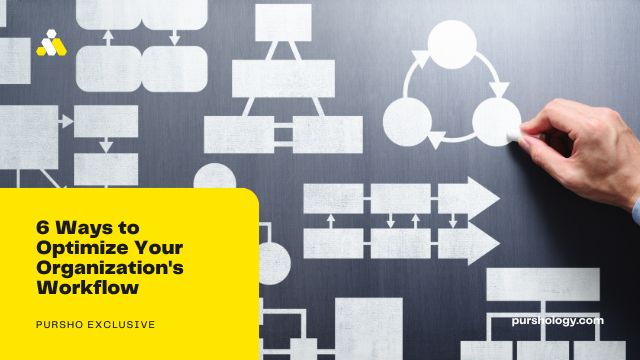Regardless of the size and the industry, business workflows play a vital role in any organization. One of the major risks businesses face today is inefficient business processes. Optimizing your business processes will boost speed, accuracy, and quality while cutting expenses and enhancing workflow efficiency allowing you to scale your business. By standardizing procedures, you will be able to start eliminating unwanted tasks and concentrating on the ones that are vital to your business operations.
An effective workflow will help drastically alter your business process and create a productive workplace. Workflows automate and simplify repetitive business operations, reducing the opportunity for error and boosting overall efficiency. Your business will benefit from effective workflow since it will enable the stakeholders to concentrate more on the production process, product quality, and delegating when necessary. This will allow them to make quicker, more informed decisions.
However, creating a process for your company is a challenging task. It frequently calls for the ability to perceive the large picture while also paying attention to the numerous minute elements that go into it, which will be pretty tricky.
Let us walk you through some fundamental ways to optimize your organization’s workflow—before that, let us dig into what workflow is.
Understanding workflow

A workflow is a planned, repeated sequence of steps to accomplish a corporate objective. Workflows and tasks are two distinct types of work performed in every business. Each assignment given to an employee is a task they must finish before moving on to the next. Every workflow consists of several discrete but related jobs distributed to certain individuals at specific workflow stages.
Workflows are typically quite linear in small firms. These routines do, however, get more complicated as an organization expands. An organization’s workflows are executed at all levels, from teams of technicians to production teams to the top level and more.
Workflows are broadly divided into:
Project workflows—While they differ from project to project, there are procedures in place to support the beginning of the project and direct it through to completion.
Process workflows—Workflows of this nature, such as those in HR and procurement, are foreseeable and regular. Systems must be put in place to assist them in navigating through the process smoothly from beginning to end.
Case workflows—These processes have a method to follow, but data must be gathered before they begin.
6 ways to improve workflows in your organization
It’s essential to understand how to increase workflow efficiency and streamline processes even though your business has established ones. You must adopt work process improvement strategies at your workplace to give process mapping top priority and boost productivity across the board. Many businesses have defined procedures in place—they are frequently dispersed, challenging to monitor, ineffective, or out of date.
The process will change depending on the methods you choose for optimization. However, there are often three steps involved while improving a process.
Identifying the process—The most vital step in the process is to identify the process as to which procedure is in question. What does it do, and who is concerned?
Evaluating the process—After the process has been identified, it must be examined to see how it functions and where improvements must be made.
Putting process changes into practice—The process optimizer must start implementing adjustments after they have a general concept of what needs to change.
Here are some ways to help optimize your organization’s workflow:
1. Use templates to streamline processes
Business templates help you operate your company more efficiently, they are a robust tool to optimize workflow and help to grow your business. There are various business form templates—you need to choose the ones that best suit your business requirements and customize them to match your brand. Whether you’re looking to collect customer information, client consultations, order type and quantity, standard type invoices, customer onboarding, or recruitment application, these templates are vital for your business.
No matter the size or type of business you have, you must start using these business form templates. Make your workflows smoother and eliminate the unwanted processes that will likely waste your time and resources. Business form templates also help to improve the efficiency of your entire team.
2. Have well-defined roles in the workflow process

Assign each workflow stage to an owner to ensure everyone knows who is in charge of what duties and how those activities fit into bigger organizational processes. It is simpler to see bottlenecks when they occur and stop your process from degrading when you know who is in charge of each phase of the workflow.
It is the responsibility of the leadership to see that workflows are followed after they have been established. Directors and other high-level executives must hold themselves and their team members accountable, or nothing will be done. Although committing to process changes will be challenging at first, doing so will ultimately lead to increased efficiency and lower costs. Accountability must be incorporated into the workflow’s structure to be effective and last.
There will always be resistance to change inside an organization. To ascertain it, leadership must decide if the team member is justified or irrational. If the former, leadership must look into it and improve the workflow.
3. Prioritize your tasks

You need to have a clear grasp of everything that must be done in the first place to decide how to prioritize your duties. You must rank the jobs that require immediate attention after becoming aware of the processes that are currently in place and documenting them in order of preference. Make a list of the tasks you have to do for each project. If you want to feel less overwhelmed, divide larger chores into smaller ones.
Add further details once your tasks have been listed and combined, like
- The time required for each task to be finished
- The degree of urgency or significance
- Due date of each task
It is crucial to realize that whatever tasks you delegate, there must be constant monitoring of the status of each project component.
4. Consider automation

Automation will contribute more to the team and the firm as a whole. Look for opportunities to automate tasks across the workflow to reduce manual busywork. When automation solutions are used, the time your staff spends on unnecessary tasks is cut down, making the investment worthwhile. By relying on automation and automating certain mundane processes, employees are often relieved of corrective tasks, giving them more time to concentrate on higher-level projects or process management as opposed to execution.
The pre-established workflows for each document do more than standardize how your teams work. They assist your business in eliminating inefficiencies and automating a variety of operations. Employers will benefit since automation significantly lowers the chance of human mistakes in manual transcribing, file management, and other processes.
5. Have improved internal communications

Most enterprises require a mechanism for simplifying communications across platforms, teams, and customers. While most firms overuse email, communication is delayed and fragmented, and crucial signals are frequently missed. As a result, relationships with clients, customers, and employees will suffer significant harm.
Businesses are able to send customized emails using automation or time-based triggers thanks to workflow optimization. This keeps communication in a single, secure area.
6. Before implementing, test and reevaluate
It is essential to test the workflow management software on smaller projects before you use it for all the departments of your organization. It will help if you gradually scale it up to larger projects until you’re sure that the software will manage projects of any complexity and that your team is trained to use it efficiently.
At the same time, you need to reassess whether your current software will continue to function effectively as your firm expands and demand increases. Sometimes, rather than completely upgrading the program, all that is needed is a change to your current process.
Ensuring the success of your workflow automation implementation
You need to take specific steps before and after to ensure workflow automation solutions operate better. Some steps required are:
Keep in mind the steps involved—Although installing the software is the first stage, keep in mind that you’ll also need to teach staff members about the new procedures. Make it obvious that the new process won’t be flawless right away and that modifications will probably be necessary.
Pick the right software application—Choose the best program for your company. You must more accurately determine which software will result in success by deciding what you require from your workflow solutions.
Keep security protocols in mind—Along with staff training, consider which security protocols are most necessary for your sector. To keep your company, staff, and clients safe, inform employees and implement these guidelines.
Have constant communication—Every individual a process will influence must be involved in open, honest communication at all times. Everyone having a say in the new process will assist in identifying problems with various phases of the automated process.
Optimizing your organization’s workflow
Workflow automation is a great fit for repetitive tasks. It has the potential to save costs and increase the efficiency of your business operations and get a better ROI. There will be fewer mistakes and less resource waste. Additionally, you will simplify your processes more quickly and with less risk.
Author Bio:
Surya Ranjan Pandita is a content marketer. He is always on the lookout for new optimization strategies and loves to create actionable content. Feel free to ping him on LinkedIn.




